
Executive Summary
Our research and practice in Information Technology and Digital Forensics has encountered many situations where stored digital information is highly desired but its storage media has been damaged. This led to the development of a sponsored research project with the National Science Foundation to explore the potential for recoverability of data from damaged media.
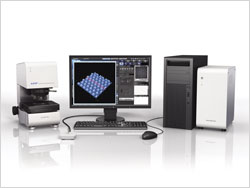 Olympus LEXT OLS4100 Laser Scanning Confocal Microscope | Optical media—primarily CDs and DVDs—has been widely used over the past 20 years. The everyday presence of CD and DVD burners in home and enterprise computers, and the low cost of writeable media, means that the public at large can burn almost everything in reach to optical media. Relatively recently, we've learned that such media is not as durable as we once imagined, but this has shown to be easily solvable using alternative and more permanent storage options. Of greater interest are situations where the only available copy of data resides on optical media, and that media has been damaged. By damaged, we mean significantly scratched, chemically altered, suffering from surface destruction, or broken into multiple pieces. In such cases, we may only have parts of the original media and wish to recover whatever data we can. |
Methodology
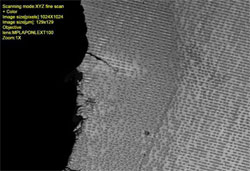 Figure 1: Image of a damaged home-burned CD. Pits and lands (encoded data) are visible as gray and white dots and dashes. These patterns were converted to 0s and 1s, then decoded to recover the original data. | Factory-pressed and home-burned optical media use different technologies: factory pressing burns physical pits into the media, while home burning causes color changes on a film layer. Fortunately, we were able to image both technologies using an OLYMPUS LEXT OLS4100 3D laser scanning confocal microscope (Fig. 1). The approach outlined here works regardless of the way the media was initially created. |
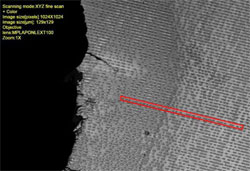 Figure 2: A string of dots and dashes selected for decoding. | Once we have a magnified image of the media, a region of consecutive dots and dashes (Fig. 2) is selected. Although the dots and dashes appear to form concentric circles, they actually form a spiral, so there are no beginnings and endings to the apparent tracks. We measure each dot and dash, then reverse the encoding algorithm used to convert the original data into the dots and dashes that were subsequently written to the media. There are only a handful of encoding algorithms in wide use, and most of these are publicly available. These algorithms don't encrypt the data, rather they simply encode it such that the information is stored efficiently and redundantly. This redundancy is significant for data recovery because it means that limited damage might not destroy all copies of original data, and we have a better chance of recovering more of the original data even in cases where we don't have the complete original media. |
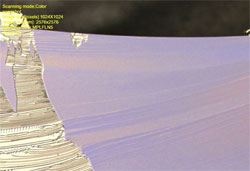 Figure 3: Image of optical disc in multiple pieces. | Damaged optical media presents a variety of challenges to those trying to recover data because damage can vary considerably. Figure 3 shows an image of an optical disc in multiple pieces. A disc may be unreadable by normal means because it is in pieces or simply due to wear such as surface scratches. Media that has been willfully destroyed such as a disc broken into multiple pieces is something that has particularly gained our attention because to a large degree the data often stays intact—it just has a damaged "container." Figure 3 depicts such a disc—we can visually see that the data appears to have suffered little impact as a result of the trauma. Using the LEXT OLS4100, we can measure the data patterns to confirm whether or not data impact has occurred. If it has, it may still be possible to adjust algorithms to handle the impact of the damage and recover the data based on the measurements. |
High magnification allows for precise measurement that can be used to help develop potential ratios for data analysis and recovery. Figure 4 is an example of a high-resolution max zoom image of data on an optical disc.
As of this writing, we have recovered data using manual decoding. Efforts are currently underway to automate this process with a computer program. The main instrument that we utilize to gather information from optical media to evaluate for potential recovery is the OLS4100, which provides the 3D visualization and measurement aspects critical to obtaining usable information from optical media. Figure 5 is a 3D data image from an optical disc.
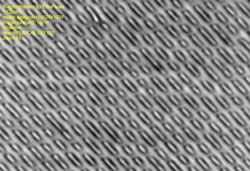 Figure 4: 17120x max zoom image of a damaged DVD | 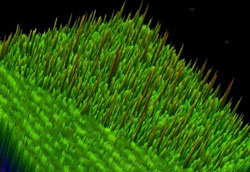 Figure 5: 3D image of data on an optical disc. |
Conclusions
There are many implications to our work. One is simply recovering data that was thought to be lost. Another is just the opposite. By understanding the characteristics that allow for potential data recovery, security techniques can be adapted so that data is unrecoverable. As an example, a common way to destroy a paper document used to be to burn it. Forensic techniques however were developed that allowed for the recovery of information that on a burned document. Document destruction techniques were then improved to account for potential forensic techniques.
While we don't purport to have solved all of the challenges necessary for efficient data recovery from damaged optical media, we have moved the ball forward in terms of refining what is possible.
Our work has been supported by the National Science Foundation under Grant No. 1116268. Any opinions, findings, and conclusions or recommendations expressed in this material are those of the authors and do not necessarily reflect the views of the National Science Foundation.
Greg Gogolin, Ph.D. (Ferris State University)
James Jones, Ph.D. (George Mason University)
Derek Brower, M.S. (Ferris State University)

